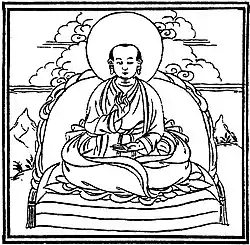Zhangton Tashi Dorje
Zhangtön Tashi Dorjé (Wylie: zhang ston bkra shis rdo rje, c. 1097 – 1167) was a Tibetan Buddhist Dzogchen teacher who was an important treasure revealer (terton) in the Menngagde lineage of Dzogchen. He is particularly known for revealing the Vima Nyingthig, a key Dzogchen cycle of teachings which includes the Seventeen tantras of Dzogchen.[1][2][3] Zhangton was born in Yamdrok Tonang and was a disciple of Chetsün Sengé Wangchuk.[1][4]

Traditional Nyingma histories hold that Zhangton had visions of Vimalamitra and discovered the Vima Nyingthig as a hidden treasure (terma) in Chimpu, Central Tibet.[5] Zhangton is also known for his authorship of The Great History of the Dzogchen Nyingtik (rdzogs pa chen po snying thig gi lo rgyus chen mo), a detailed chronological account of the Dzogchen tradition and lineage.[1][3][6] Zhangton's main successor was his son Nyibum.[5]
Some modern Tibetologists like David Germano and Christopher Hatchell think that Zhangton may have been the main author of the Vima Nyingthig.[2][3]
References
- "Zhangton Tashi Dorje". The Treasury of Lives. Retrieved 2022-01-10.
- Germano, David; Gyatso, Janet (2001), "Longchenpa and the Possession of the Dakinis", in White, David Gordon (ed.), Tantra in Practice, Motilal Banarsidass Publ.
- Hatchell, Christopher (2014), Naked Seeing The Great Perfection, the Wheel of Time, and Visionary Buddhism in Renaissance Tibet, p. 54. Oxford University Press
- Dudjom Rinpoche 1991, p. 559
- Dudjom Rinpoche 1991, p. 561.
- Samten Karmay (2007). The Great Perfection (rdzogs chen): A Philosophical and Meditative Teaching of Tibetan Buddhism. Second edition, p. 211. BRILL.
Sources
- Dudjom Rinpoche (1991). The Nyingma School of Tibetan Buddhism, Its Fundamentals and History, trans. and ed. by Gyurme Dorje. Boston: Wisdom Publications, pp. 559–561.
- Nyoshul Khenpo, A Marvelous Garland of Rare Gems: Biographies of Masters of Awareness in the Dzogchen Lineage (Junction City: Padma Publications, 2005), pp. 86–88.